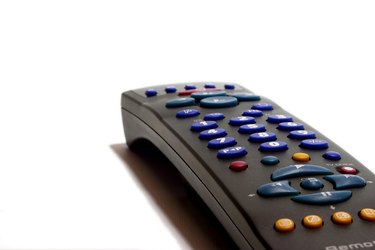
You might be surprised to learn that the plastic that makes up the sewer pipes in your home is the same plastic often used in the making of a TV remote. Remotes were first used by the military in both World War I and II for operating motorboats, bombs and other weapons until they found their way into the living room during the 1950s. The first official TV remote, engineered by Zenith, "Lazy Bones," was a cumbersome remote with a box attached to an unwieldly cable that controlled channel changes. Today's remotes are wireless technical wonders using infrared or radio frequencies for communication.
TV Remote Case
Video of the Day
The case of a TV remote is formed from a molded plastic, typically the same type of plastic used in drain-waste vent systems, acrylonitrile butadiene styrene or ABS. The plastic is heated and injected into a mold to take the shape of the TV remote case. Thermally conductive polymers are also used to dissipate heat built up by the remote. The plastic also often requires electromagnetic and radio frequency interference shielding to protect the remote against interference from other wireless devices.
Video of the Day
Screens and Covers
Some remotes come equipped with small screens, while all have a plastic cover that encases the TV remote signal area. For the remote to work, it sends either a radio frequency or infrared signal to the device it controls. This remote eye typically sits at the top of the remote encased in a plastic called acrylic or a polycarbonate. Other plastics that can be used in clear plastics include ABS, nylon, silicone, styrene and thermoplastic polyurethane, known as TPU and thermoplastic elastomers, or TPEs.
Buttons
Keypads and buttons are made from any number of thermoplastic elastomers because of their "rubbery" composition. Most of the TPEs used for buttons and keypads are propriety in nature, meaning the formula is trademarked and kept secret. Some of these TPEs include Estane, Arnetell, Santoprene, Pellethane, Dynaflex, Polytrope or Sarlink and more. Thermoplastic elastomers are plastics that have give, bounce or a rubbery texture.
Filled Plastics
Sometimes to increase the strength of the plastics used in making television remotes, fillers are used. Fillers are added during the injection molding process and may include glass, carbon, aramid or stainless steel fibers. Aramid fibers are typically known under the names of Kevlar, used in bulletproof vests and Nomex, used as a flame resistant material, both of which provide added strength without extra weight.
- The Great Idea Finder: Remote Control
- American Precision Products: Molding with Engineered Polymers
- American Precision Products: Conductive Thermoplastic
- Polymer Science Learning Center: Elastomers
- American Precision Products: Molding with Filled Engineering Materials
- University of Wisconsin: Aramid Fibers